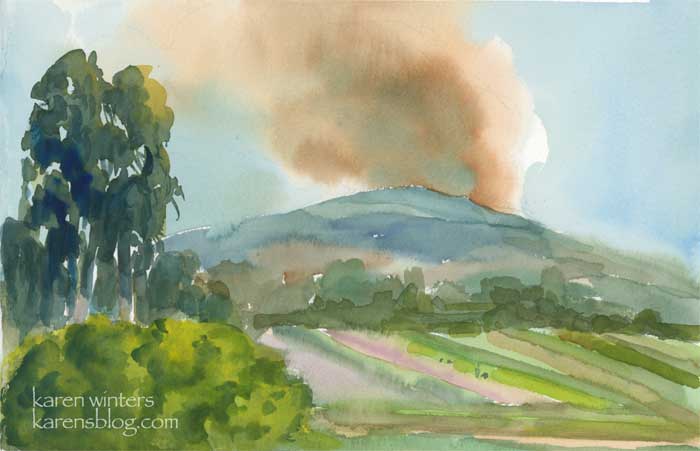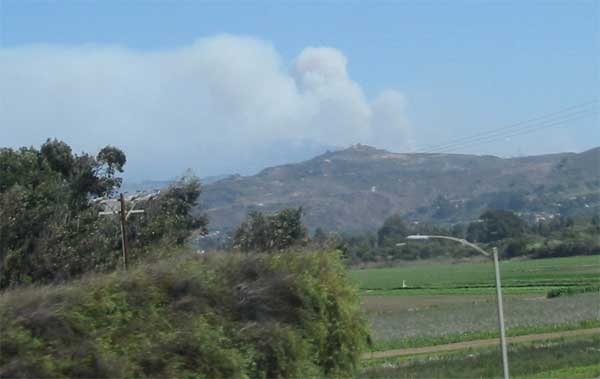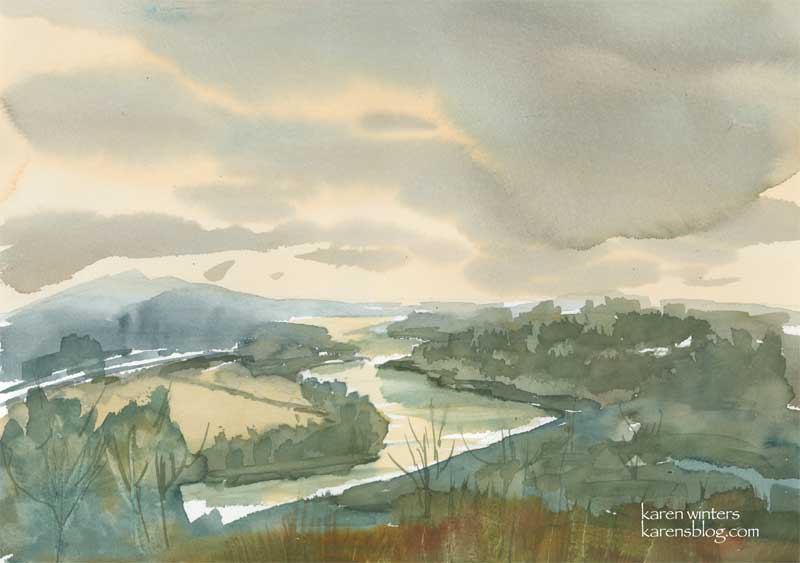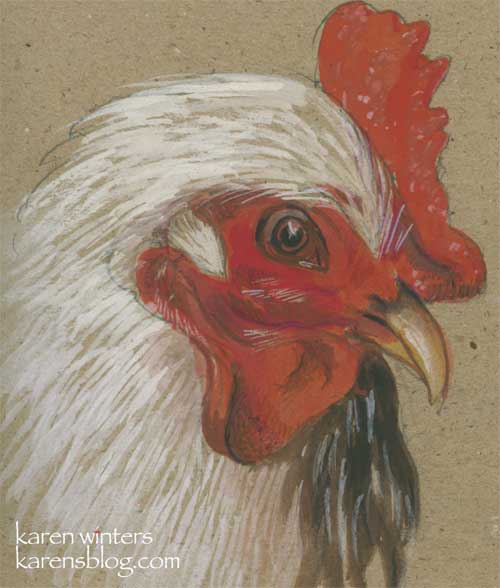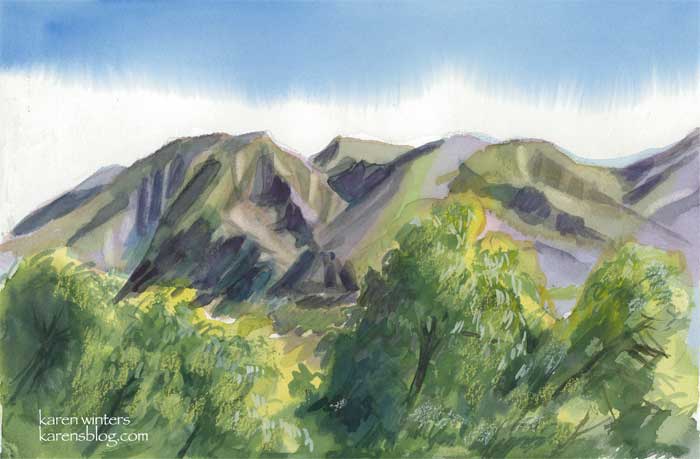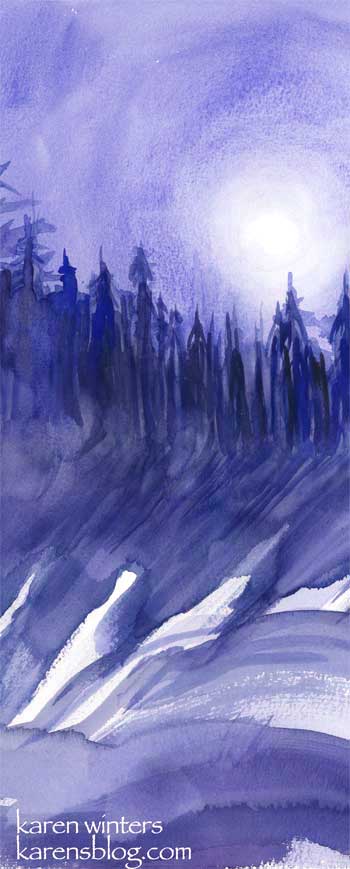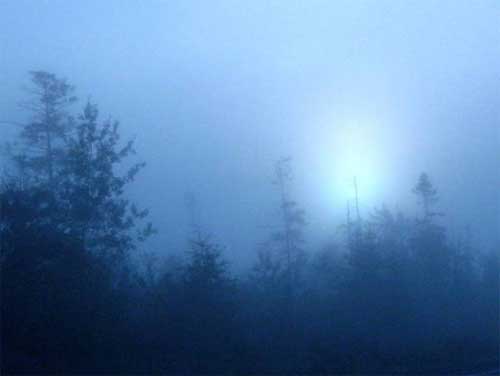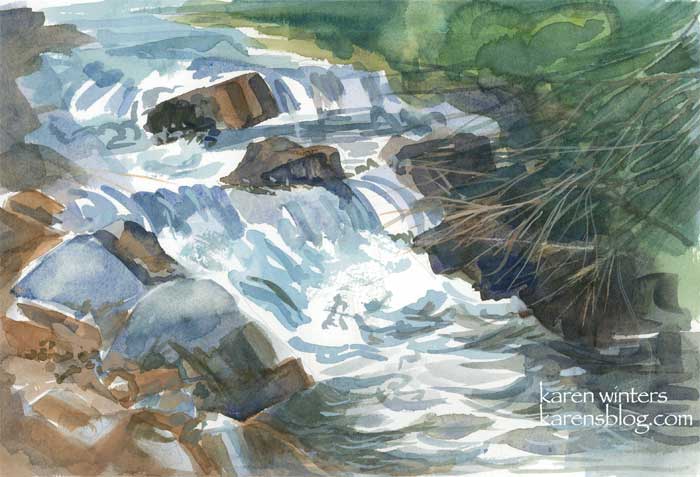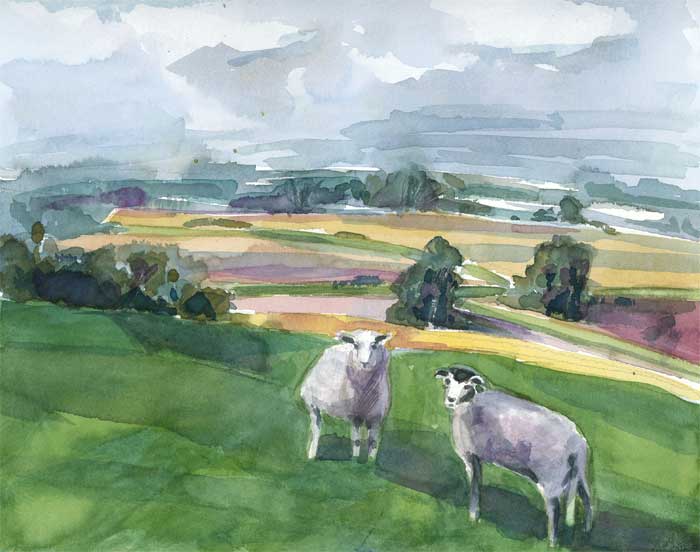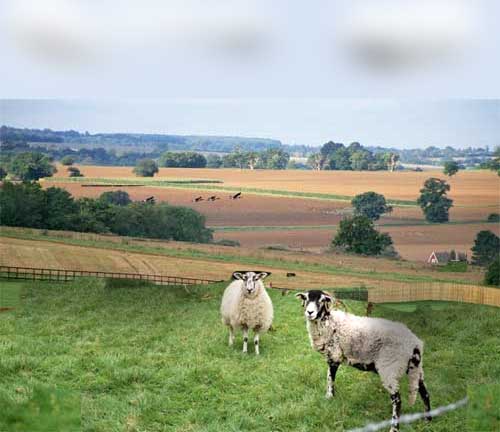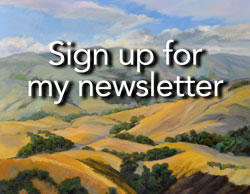Fire in Ojai – Daily Painting
“Fire in Ojai” – 11 in. x 7 in. Watercolor on 140# paper
Yes, there is a theme this week in my painting – clouds and skies. This one came about for a few different reasons.
1) I was looking for a different kind of cloud to paint
2) I wanted some practice doing eucalyptus trees
3) My talented art friend Ron Guthrie posted a wonderful painting on Wet Canvas today based on a photo of the San Gabriels he took from the freeway – and that reminded me of a freeway shot I’d taken earlier this year that might be good for cloud/smoke practice.
The backstory: My husband and I were driving up to Santa Barbara for a meeting and I saw a plume of smoke rising in the distance. Because I have my camera in my lap whenever we drive anywhere I got a few shots of the Ojai fire which had just started that morning.
As you can tell, I made quite a few changes, just using the photo as a starting point to remind me of the shape of the plume and the geometry of the mountains and agricultural fields. I borrowed the euc from another one of my photos.
I’ve been studying the California regional painters this year, and I’ve noticed that not all of the scenes they painted are pretty landscapes. Often they represent an incident – a moment in time. So this is a tip of the hat to the spirit of those painters and their storytelling power.
Daily Painting – Asheville River
French Broad River – 14.1 inches by 9.5 inches
This painting represents a bit of a turning point for me, and one that I hope takes me into new and interesting directions. The painting is of the French Broad River above Asheville, North Carolina, from a monochrome picture more than 100 years old which I found in a vintage book which belonged to my father in law. In the picture, there were no clouds and it was printed in drab sepia. I’m assuming that the picture may have been mid or late summer fom the amount of foliage on the trees, but that’s only a guess. It could have been mid-fall also. But for the purposes of this painting, it really doesn’t matter because I decided to invent a sky and a color palette that pleased me, regardless of what reality presented the day the picture was taken. I used mostly earth tones – raw sienna, a drab red, burnt sienna, prussian blue
In the coming year, I’m finally going to start working larger and with more expressive and inventive color, rather than just trying to render what I see in front of me. I feel like I’m already heading that way but I need to push it further, step by step and to continue loosening up. This painting, for example, was painted with only two brushes, a one inch flat Japanese brush and a No. 2 rigger – so named because it was good for painting the rigging of ships.
By the way, perhaps someone from around Asheville can tell me where this picture was taken and what it looks like today. I would imagine that there would be more bridges crossing it, and maybe it is developed with housing or businesses.
Edited to add: Thanks to Nancy at Wet Canvas for adding details about the location of this and the reassurance that it probably still looks pristene today.
I’m adding the reference photo for those who may be interested to see what I started with and where I ended up. Keep in mind that my objective was to compress the landscape down into the lower 1/3 or so of the page so as to exaggerate the sky, which means taking some liberties with geographical features.
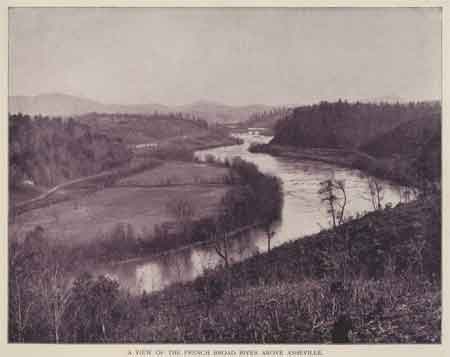
Chicken – Daily Painting
Study of a chicken … 5″ x 6″ – gouache on recycled paper
I thought the recycled paper worked well for this. In fact, the little bits of fiber in the paper reminded me of the sort of straw and dust found in barnyard environments and gave me a nice midtone to work against.
Pepper Trees – Daily Painting
“Pepper Trees near Lake Piru” 7.5″ x 11″ Watercolor on 140# paper
For sale
Almost as common as eucalyptus are California’s pepper trees, which, in the summer, are heavily laden with pink peppercorns. These tall fluffy trees are especially common along highways, and scent the air with a spicy fragrance when the fallen peppers are crushed.
After I painted this I thought it almost verged on the abstract with large bands of color, shape and texture but no real center of interest.
Crest Pines
“Crest Pines” 15″ x 11″ watercolor on paper
Pines and summer wildflowers on the Angeles Crest – the newest in my trails of the San Gabriel series.
This weekend, at two different watercolor demos held at Watercolor West and the National Watercolor Society, both demonstrating artists mentioned how they like to work in themes and series. I hadn’t been consciously thinking that way, but I now realize that I keep doing similar paintings of trails or byways and our local mountains. So I guess you could call that a series. Although I don’t know that I’ll make every upcoming painting a part of that, I’m sure that tomorrow’s plein air is likely to be a continuation, and I’ll be doing more in the future. I do find that by working consistently on similar subject matter that it reinforces what I’m learning and experimenting with.
As with others in this series, the only pencil drawing was about a half a dozen lines to indicate horizon, mountain range, the shapes of the two prominent pines and the shape of the trail. Everything else was ‘drawn’ with the brush as I painted.
I used about four brushes for this: a one inch flat, a 12 round, a 4 round and a #6 liner. The colors were primarily chrome yellow, thalo blue, payne’s gray and a bit of leftover burnt sienna from yesterday’s painting
Snowy Field – Painting a Day
Snowy Field
Watercolor on paper 5.5″ x 13.5″
An exploration in monochrome for a Wet Canvas Weekend Allmedia event. The challenge was to take a reference photo provided by Wendy/Sundiver and adapt it in some way to make it more interesting.There was no foreground in the ref photo, and no shadows. My solution was to turn it into a vertical format, rather than horizontal, and to let the cast shadows of the trees be part of the design. The shadows point up to the sun (or moon, as the case may be) which is the center of interest.
Now if any of you wants to get technical, yes I know that the cast shadow from a point source (the moon) should radiate from that source, and that the trees furthest to the right should not cast shadows to the left. But I did it for a design reason, ok?
Illo Friday “Clear” – Wild Stream
SOLD
“Wild Stream”
7.5″ x 11″ Watercolor on 140# paper
Clean, clear, water – what a precious resource. Can anything match it for clarity and freshness?
I did this painting today just for fun for some water practice, using a very limited palette of two blues, a red and a yellow. That’s about it. Oh, and a little gouache white for some ripples here and there. The Angeles Crest forest above La Canada is just full of places like this.
I don’t think there’s any way to paint wild water in a quiet, contemplative way. For me, it’s necessary to be a little bit excited about the subject matter and to paint quickly and almost impulsively, even though that usually means making a lot of mistakes. The vitality of the water flow is communicated by the energy of the brushstrokes.
(My watermark and blogaddress is not in the painting – only in the scan.)
Yorkshire Pals – Daily Painting
11″ x 9″ Watercolor on 140# paper. Available.
This was my (very) early morning project for Wet Canvas’ weekend drawing event, in which reference photos are provided to draw or paint from. One’s work or work in progress must be posted within 2 hrs of starting.
Well, I had a dilemma. I liked parts of two photos but I wasn’t sure either one would make a good painting on their own. So I composited the two in Photoshop and used that as my ref.
Something I observed this week at LACMA when I wandered through the 18th century landscape galleries. Almost all of the skies were full of interesting cloud formations – and the reason appeared to be so that certain landscape elements could be highlighted by the sun, and other, less interesting parts thrown into shadow. Hmm, pretty clever those Dutch. So it occurred to me that I could make a more interesting pattern of light and darkness on the ground if I put some clouds up into the sky. (Look at the horse photo and you’ll see it’s a clear day.) The fluffy clouds I experimented with in Photoshop were my way of seeing if that solution would work. I also wanted some strong diagonals in the composition so I exaggerated that with color and shadows.
Here are the two source photos which were taken by Deepat’s friend June
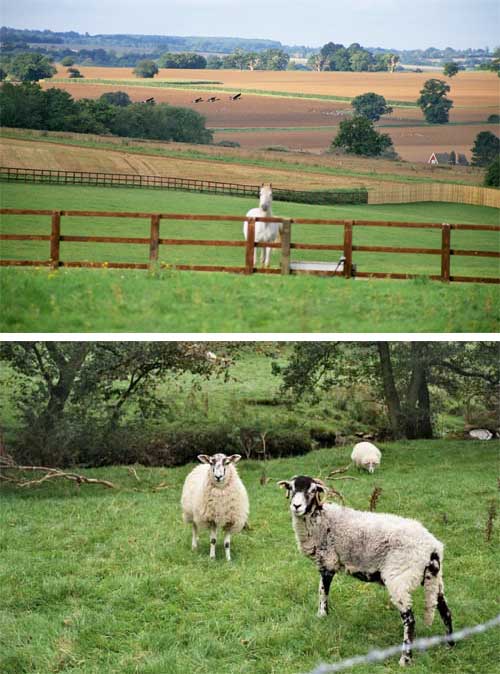
Something winged this way comes
I am frustrated today because my Yahoo email is bouncing and every reactivation request I’ve put in is not working. I get error messages back that reassure me that Yahoo is working hard to upgrade its sites to serve me better and if I don’t hear anything after 4 hrs to get updates here (and then it shuttles me to a generic FAQ page. Updates? Hah! Nada.) I don’t know what else I can do now but wait. I’ve followed all the steps including trying to reactivate myself from a group I moderate.
So this lack of results has put me in a rather peevish mood, but since it’s Halloween and the time for the thinning of the veils and such, I’ll tell you a story of synchronicity.
Many years ago, oh best beloved, my dh and I were on an expedition in Egypt searching for ancient artifacts using remote viewing. It was tiring and hot but we loved nearly every minute of it, and cherished the moments that we could see other parts of that beautiful and fascinating country. One early evening, our drivers took us out to Saqqara where we watched sunset near the bent pyramid of Zoser. We sat on a hillside covered with loose rocks and rubble. I put my hand down and picked up one rock, turned it over, and there was a hieroglyphic of an ibis, headless. But the body clearly told me what kind of bird it was. That was a rare moment, holding a piece of history in my hand, rescued from what looked like a landfill.
Flash forward ten years or more, to another turbulent time. We were working on a show that had to do with native americans and the settling of the west, and I was looking for some props to use in filming a sequence. A chance visit to a garage sale (unrelated) turned up a bead loom with a bead weaving half completed. There was the ibis-like wading bird, again … but this time, without a tail. It felt like a visitation from an old friend.
Ibises in art seem to speak to me in some way. A benign, good way, even if they are headless. So, today when my dh had a meeting in Beverly Hills and offered the opportunity to ride along and go to the LA county art museum, I jumped at the chance. I had HAD it up to here with bouncing emails, thankfully a rare occurrence. On Halloween the museum was empty. I had the place to myself and I reveled in it. You can imagine my smile rounding the corner into the Egyptian gallery and coming across this beautiful bronze of an ibis which may have once been on a royal standard. I just had to stop and draw it, head, wings, tail and all.
When I got home tonight, I did a little research on the ibis and its symbolism. The bird is sacred to the Egyptian deity Thoth, the civilizer of men, who taught music, medicine, writing and magic and was associated with speech, literature, the arts and learning. And most appropriate today, on all hallows eve, Thoth was the author of the Book of the Dead, and he who helped or punished the departed as they made their trek to the underworld.
On these days when some believe the veil between worlds may thin, who knows what power ancient symbols may still hold – even if only to grant a smile and a moment of relaxing drawing pleasure.
